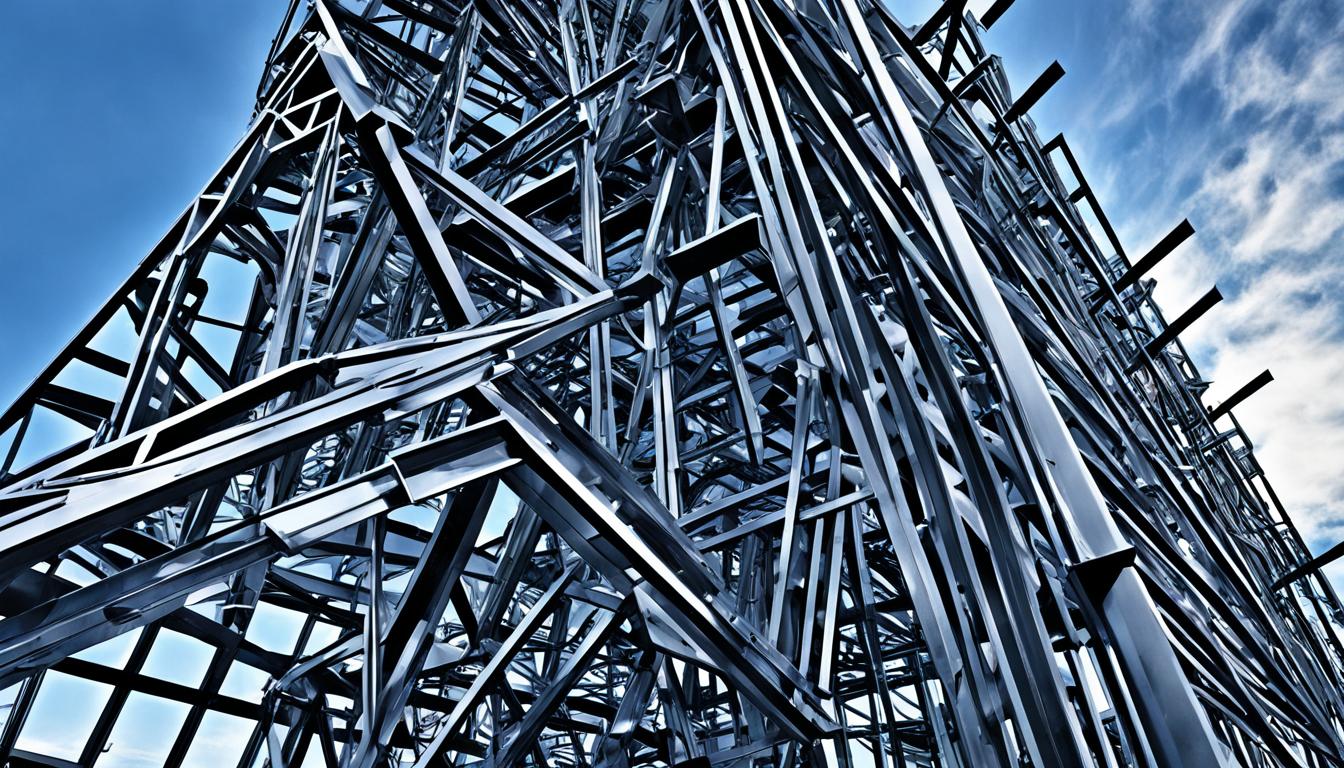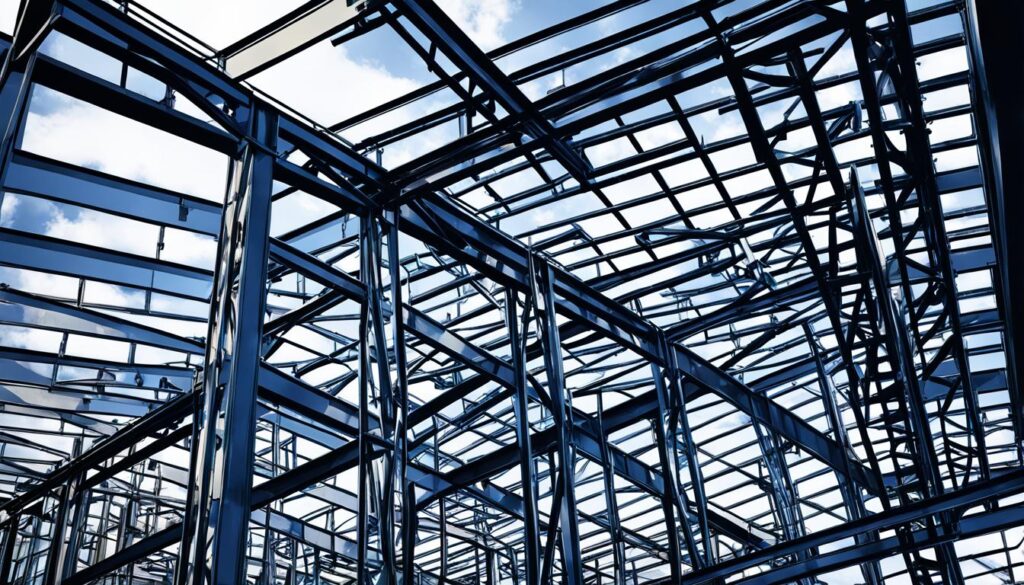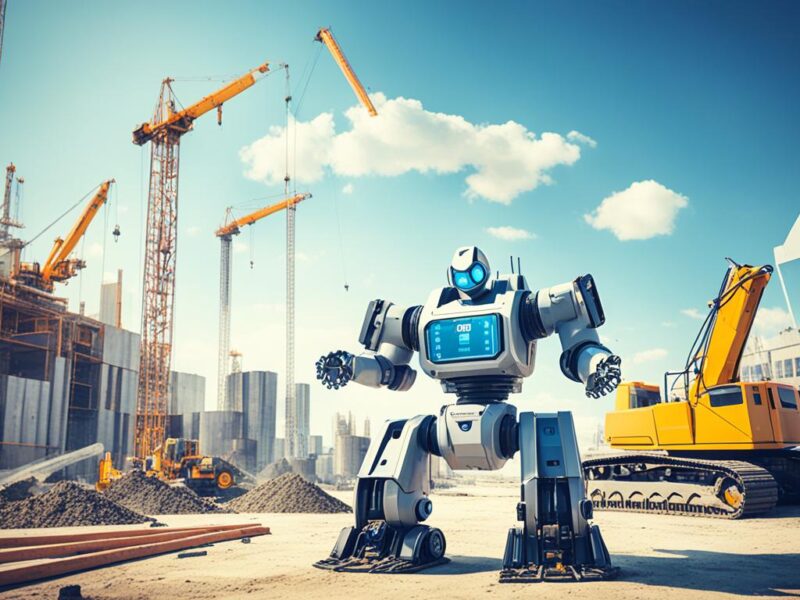
Innovations in Cold-Formed Steel Construction
Did you know that steel construction accounts for approximately 50% of all non-residential buildings in the United States?
Steel has long been recognized for its strength and durability, making it a popular choice in the construction industry. But recent innovations in cold-formed steel construction techniques have taken this material to new heights, revolutionizing the way buildings are designed and erected.
Key Takeaways:
- BIM technology allows for intelligent incorporation of detailed information.
- EQ coatings enhance corrosion resistance.
- Resilient channels improve sound transmission loss.
- Adjustable studs provide flexibility.
- Innovative manufacturing techniques produce high-yield-strength EQ studs.
Advancements in Steel Framing Techniques
Cold-formed steel framing has seen significant advancements in recent years, revolutionizing the construction industry. Steel framing is not only known for its strength and durability but also for its versatility and cost-effectiveness. In this section, we will explore the innovative techniques and technologies that have propelled steel framing to new heights.
Digital Design and Forming with LifeTec
LifeTec, a leading steel construction company, utilizes a cutting-edge cold-formed steel framing system that leverages digital design and manufacturing processes. Using advanced software, LifeTec digitally designs and precisely forms wall panels, floor joists, and roof truss parts. This approach improves construction efficiency and accuracy, ensuring a seamless fit and reducing waste.
By employing state-of-the-art roll-forming methods, LifeTec can create standardized specialty elements, simplifying the detailing process and enhancing installation consistency. These specialized elements, such as tracks with drainage holes and improved stud designs, enhance the overall durability of the steel framing system, reducing the risk of moisture-related problems and extending the longevity of the building.
Standardized Pre-fabricated Connections
One of the key advancements in steel framing techniques is the development of standardized pre-fabricated clips for header systems. These clips improve connection strength while maintaining the aesthetic appeal of the building. By incorporating these pre-fabricated connections, steel contractors can save time and labor during the construction process, ensuring efficient and reliable connections.
Benefits of Advanced Steel Framing Techniques
The advancements in steel framing techniques offer a wide range of benefits for both contractors and building owners. Steel framing is known for its affordability, speed of construction, and lightweight properties, making it an attractive choice for various projects, from residential homes to large metal buildings.
Furthermore, steel framing is non-combustible and highly resistant to rot and termite infestation, ensuring the longevity and safety of the structure. The insulation capabilities of steel framing contribute to the building’s energy efficiency and provide excellent acoustic performance.
The following table highlights the advantages of advanced steel framing techniques:
| Advantages | Description |
|---|---|
| Affordability | Cost-effective solution for construction projects |
| Speed of Construction | Quick and efficient installation process |
| Lightweight | Easier handling and transportation on construction sites |
| Non-Combustible | Enhances fire resistance of the building |
| Insulation Capabilities | Provides effective acoustic and thermal insulation |
| Resistance to Rot and Termites | Long-lasting durability and minimal maintenance |
These advancements in steel framing techniques have propelled the industry forward, providing innovative solutions for construction projects. Steel contractors and metal building manufacturers can now leverage these techniques to deliver high-quality structures that are not only durable but also environmentally sustainable.
The Role of Cold-Formed Steel Framing Standards
Cold-formed steel framing (CFSF) has gained widespread acceptance in both commercial and residential construction. Its affordability, speed of construction, and numerous other benefits have made it a popular choice in the industry. To ensure consistency, quality, and safety in CFSF projects, the American Iron and Steel Institute (AISI) established the first design standards for CFSF in 1946, with the latest version being AISI S 200-07.
The standardization of CFSF has played a crucial role in its wide adoption for both load-bearing and non-load-bearing applications. By providing guidelines and specifications, these standards have facilitated the efficient design and construction of steel-framed structures. Architects, engineers, and contractors can rely on these standards to ensure their projects meet the necessary structural requirements and performance expectations.
However, despite the benefits of standardized CFSF, there have been challenges in customizing rough openings and other structural elements to suit specific design needs. To address these challenges, the use of pre-engineered specialty elements has emerged. These elements offer greater versatility and flexibility, allowing for easier customization while maintaining the overall consistency and reliability of CFSF.
“Standardization has been a game-changer for cold-formed steel framing. It has not only increased efficiency and reduced costs but also improved the overall quality and durability of the structures we build.”
– John Anderson, Structural Engineer
With the role of standardization and the integration of pre-engineered specialty elements, CFSF has evolved into a reliable and versatile construction method for a wide range of projects. From residential homes to commercial buildings, load-bearing and non-load-bearing applications, the use of cold-formed steel framing continues to grow, ensuring the durability, efficiency, and sustainability of modern construction.

Table: Comparison of Load-Bearing and Non-Load-Bearing Applications of Cold-Formed Steel Framing
| Applications | Load-Bearing | Non-Load-Bearing |
|---|---|---|
| Structural Walls | ✓ | ✓ |
| Floor Systems | ✓ | ✓ |
| Roof Systems | ✓ | ✓ |
| Partition Walls | ✓ | ✓ |
| Exterior Cladding | ✓ | ✓ |
| Interior Finishes | ✓ | ✓ |
Advantages of Cold-Formed Steel Framing
Cold-formed steel framing offers numerous advantages over traditional wood framing. Its use in construction projects provides a range of benefits that contribute to the durability, efficiency, and sustainability of buildings.
- Lightweight: Cold-formed steel framing is significantly lighter than wood framing, making it easier to handle and transport on construction sites. This lightweight characteristic simplifies the construction process and reduces labor requirements.
- Non-Combustible: One of the key advantages of cold-formed steel framing is its non-combustible nature. Unlike wood, steel studs and track do not burn or contribute to the spread of fires. This feature enhances the fire resistance of buildings and ensures the safety of occupants.
- Effective Insulation: Cold-formed steel framing is easy to insulate, allowing for effective acoustic and thermal insulation. Insulation materials can be easily installed within the steel framing, providing energy efficiency and soundproofing benefits.
- Resistance to Rot, Mold, and Termites: Unlike wood, cold-formed steel framing is resistant to rot, mold growth, and termite infestation. This durability ensures that the structural integrity of buildings remains intact over time and reduces maintenance requirements.
- Environmental Sustainability: Cold-formed steel framing is environmentally sustainable, as it has a high recycled content. The use of recycled steel in construction projects minimizes the demand for new raw materials, reduces waste, and contributes to a more sustainable building industry.
Overall, the advantages of cold-formed steel framing, including its lightweight nature, non-combustibility, insulation capabilities, and resistance to rot and termites, make it an excellent choice for construction projects. Its environmental sustainability further enhances its appeal in the context of modern architectural designs.
Real-World Example: The Benefits of Cold-Formed Steel Framing in Commercial Construction
“Cold-formed steel framing has revolutionized our approach to commercial construction. Its lightweight characteristics allow us to construct large structures efficiently and quickly. Moreover, the non-combustible nature of steel studs gives us peace of mind when it comes to fire safety regulations. The insulation capabilities provide enhanced acoustic comfort for office spaces, ensuring a productive work environment. Additionally, the resistance to mold and termites ensures our buildings remain structurally sound for years to come. Cold-formed steel framing has truly transformed how we build.”
– Michael Johnson, Lead Architect at SteelCraft Architects
In conclusion, the advantages of cold-formed steel framing, such as its lightweight nature, non-combustibility, insulation capabilities, and resistance to rot and termites, make it an ideal choice for construction projects across various sectors. Its reliability, durability, and environmental sustainability contribute to its increasing popularity in the building industry.
Conclusion
Innovations in cold-formed steel construction techniques have revolutionized the structural steel industry. The use of advanced technologies like BIM has allowed for more intelligent and efficient steel design, resulting in enhanced efficiency, durability, and sustainability in steel construction projects. Additionally, the application of EQ coatings on steel framing elements has significantly improved their corrosion resistance, increasing the lifespan of steel structures.
Furthermore, the integration of mobile design tools and the development of pre-engineered systems have streamlined the construction process, reducing time and resource consumption. These advancements, coupled with the standardization of specialty elements and improved connections, have made cold-formed steel framing a reliable and cost-effective choice for both load-bearing and non-load-bearing applications in the building industry.
With its lightweight nature, non-combustible properties, insulation capabilities, and resistance to rot and termite infestation, cold-formed steel framing offers multiple advantages over traditional wood framing. Moreover, the high recycled content of steel materials contributes to its environmental sustainability.
Overall, the continuous advancements in steel construction and design have solidified the position of cold-formed steel framing as a leader in the building industry, offering durability, efficiency, and cost-effectiveness for a wide range of construction projects.







